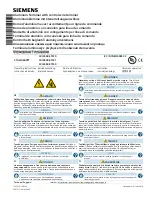
51
Chapter 11: Commanding the ISDN TA/V
11.4.1 F
ORMATTING
C
OMMAND
L
INES
With the exception of two commands, all command lines must begin with the
letters
AT
.
This can be typed in either upper or lower case, but not in a mixture of upper
and lower case. The two commands that prove an exception to this rule are
detailed later in this section.
AT
is a command by itself in that it is used to bring the ISDN TA/V to
ATtention. However, for the purpose of understanding the AT command
language and how it is used, you should think of the letters
AT
as a prefix
rather than a command.
The ISDN TA/V configuration or dialing command follows the
AT
prefix.
Spaces can be inserted but they will be ignored by your ISDN TA/V. Each
character in a string is then stored in your ISDN TA/V’s memory until a
“terminator character” is entered, marking the end of a command line. Once
the terminator character reaches the ISDN TA/V, the command buffer is
emptied and the command is executed.
A command line must end with a terminator character, the default character
for this being a carriage return
<CR>
. This character option can be altered if
necessary by changing the appropriate ISDN TA/V S-register setting (ISDN
TA/V S-registers, their function and possible settings are explained later in
this manual).
Many commands have two or more possible options, the setting of which
determines the operating characteristics of that particular function of your
ISDN TA/V. Each and every command has a factory setting which varies
according to the ISDN TA/V configuration being used. The command’s
numeric parameter indicates which option is selected. For example, with the
Q
command set to
Q0
the ISDN TA/V will respond to commands by
reporting result codes back to screen, and when this is set to
Q1
the ISDN
TA/V will not report these result codes.
If you issue a command without specifying a numeric parameter, the ISDN
TA/V will assume that the 0 option is to be used. For example, if you issue the
command
ATQ<CR>
this will be interpreted by the ISDN TA/V as
ATQR0<CR>
.
The
Sn=r
command (used to control special memory locations within the
ISDN TA/V called S-Registers), the
&Zn=x
command (for storing numbers in
the ISDN TA/V’s memory) and the
DS=n
command (for dialing stored ISDN
numbers) have a slightly different format from all other commands. Here,
instead of specifying the option directly after the command, an equal sign (=)
and a number provide the value. Refer to the appropriate sections in this
manual for detailed descriptions of these commands and their use.
Содержание IS300AE
Страница 7: ...8 ISDN TA V Part I Getting Started ...
















































